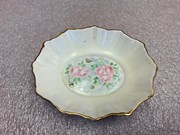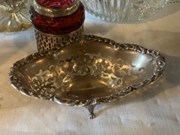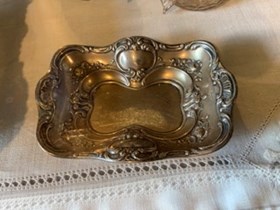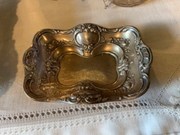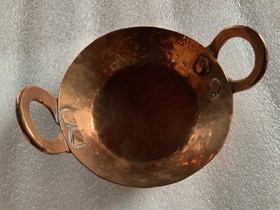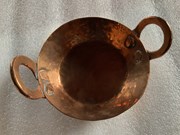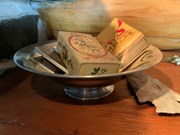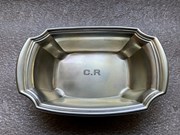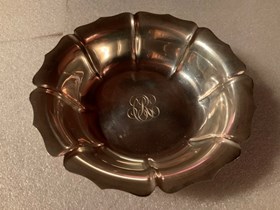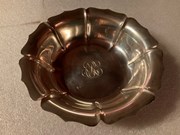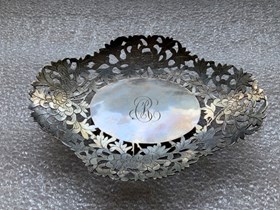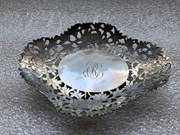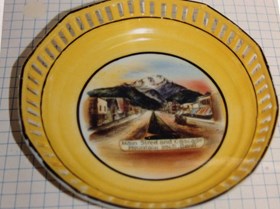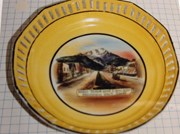Narrow Results By
- Photograph 29380
- Negative 17287
- Library - Book (including soft-cover and pamphlets) 14564
- Transparency 3187
- Library - Periodical 3157
- Library - Postcard 2944
- Textual record 2814
- Lantern slide 2559
- Map 2131
- Photograph print 2118
- Library - Maps and blueprints (unannotated; published) 1823
- Graphite Drawing 1627
- Date
- n.d.
- Material
- glass
- Catalogue Number
- 104.20.0889
- Description
- A small glass dish with a fluted design. The edge is slightly scalloped.
1 image
- Title
- Candy Dish
- Date
- n.d.
- Material
- glass
- Dimensions
- 5.0 x 13.0 cm
- Description
- A small glass dish with a fluted design. The edge is slightly scalloped.
- Subject
- Moore home
- dining
- decor
- Credit
- Gift of Pearl Evelyn Moore, Banff, 1979
- Catalogue Number
- 104.20.0889
Images
This material is presented as originally created; it may contain outdated cultural descriptions and
potentially offensive content.
Read more.
- Date
- n.d.
- Material
- china; ceramic
- Catalogue Number
- 104.20.1281
- Description
- A small white china dish with fluted edge. Edge painted with gold. Interior base of dish roughly painted with design of pink flowers with green leaves and blue background. On base is gold stamp of a crown and the words “ROYAL ALBERT BBone China ENGLAND Val Dor” below. Written in gold around the edg…
1 image
- Title
- Candy Dish
- Date
- n.d.
- Material
- china; ceramic
- Dimensions
- 5.0 x 13.0 x 15.0 cm
- Description
- A small white china dish with fluted edge. Edge painted with gold. Interior base of dish roughly painted with design of pink flowers with green leaves and blue background. On base is gold stamp of a crown and the words “ROYAL ALBERT BBone China ENGLAND Val Dor” below. Written in gold around the edge of the base is “SISTER Maude Kidney ReBeHak 60th YEAR PAINTED BY ZITA SMYTH” and an illegible date. Upper exterior surface has mother-of-pearl like glaze.
- Subject
- Whyte home
- decor
- dining
- Credit
- Gift of Catharine Robb Whyte, O. C., Banff, 1979
- Catalogue Number
- 104.20.1281
Images
This material is presented as originally created; it may contain outdated cultural descriptions and
potentially offensive content.
Read more.
- Date
- 1875 – 1925
- Material
- metal, silver
- Catalogue Number
- 104.20.0057
- Description
- A shallow sterling silver bowl with a narrow flat bottom and flaring sides which have a pierced design. There is heavy silver trim along the edge of the bowl. The bowl is supported on four small silver legs at the base. The bowl is marked “Kyrie Sterling”.
1 image
- Title
- Candy Dish
- Date
- 1875 – 1925
- Material
- metal, silver
- Description
- A shallow sterling silver bowl with a narrow flat bottom and flaring sides which have a pierced design. There is heavy silver trim along the edge of the bowl. The bowl is supported on four small silver legs at the base. The bowl is marked “Kyrie Sterling”.
- Subject
- households
- decorative
- Credit
- Gift of Pearl Evelyn Moore, Banff, 1979
- Catalogue Number
- 104.20.0057
Images
This material is presented as originally created; it may contain outdated cultural descriptions and
potentially offensive content.
Read more.
- Date
- 1875 – 1925
- Material
- metal, silver
- Catalogue Number
- 104.20.0058 a,b
- Description
- A pair of sterling silver rectangular dishes with shallow flaring sides. The sides of each dish have an ornate raised floral pattern that leaves a smooth hourglass shape in the bottom of the dish. Both dishes are hallmarked sterling and are also marked “A 2694 712690”.
1 image
- Title
- Candy Dish
- Date
- 1875 – 1925
- Material
- metal, silver
- Dimensions
- 12.5 cm
- Description
- A pair of sterling silver rectangular dishes with shallow flaring sides. The sides of each dish have an ornate raised floral pattern that leaves a smooth hourglass shape in the bottom of the dish. Both dishes are hallmarked sterling and are also marked “A 2694 712690”.
- Subject
- households
- decoarative
- food
- Credit
- Gift of Pearl Evelyn Moore, Banff, 1979
- Catalogue Number
- 104.20.0058 a,b
Images
This material is presented as originally created; it may contain outdated cultural descriptions and
potentially offensive content.
Read more.
- Date
- 1945 – 1955
- Material
- metal, copper
- Catalogue Number
- 104.20.0100
- Description
- A shallow copper bowl with a flat bottom and two loop handles attached at the rim with large rivets. The copper shows texture from beating.
1 image
- Title
- Candy Dish
- Date
- 1945 – 1955
- Material
- metal, copper
- Dimensions
- 3.5 cm
- Description
- A shallow copper bowl with a flat bottom and two loop handles attached at the rim with large rivets. The copper shows texture from beating.
- Subject
- households
- decorative
- crafts
- metalwork
- Credit
- Gift of Pearl Evelyn Moore, Banff, 1979
- Catalogue Number
- 104.20.0100
Images
This material is presented as originally created; it may contain outdated cultural descriptions and
potentially offensive content.
Read more.
- Date
- 1920 – 1930
- Material
- metal
- Catalogue Number
- 104.20.0228
- Description
- Small shallow pewter bowl slightly flaring at the lip and set on a low foot. Marks: on base, "L.H. Vaughan Taunton, Mass. pewter" with the number '169' scratched above and their pewter mark inside square below.
1 image
- Title
- Candy Dish
- Date
- 1920 – 1930
- Material
- metal
- Dimensions
- 4.5 x 14.4 cm
- Description
- Small shallow pewter bowl slightly flaring at the lip and set on a low foot. Marks: on base, "L.H. Vaughan Taunton, Mass. pewter" with the number '169' scratched above and their pewter mark inside square below.
- Subject
- households
- Credit
- Gift of Catharine Robb Whyte, O. C., Banff, 1979
- Catalogue Number
- 104.20.0228
Images
This material is presented as originally created; it may contain outdated cultural descriptions and
potentially offensive content.
Read more.
- Date
- 1920 – 1930
- Material
- metal
- Catalogue Number
- 104.20.0532
- Description
- Flat based, shallow, rectangular dish with angled corners and sloped sides which terminate in double ridged rim. Rim lip folded over. "Gorham" followed by three hallmarks and Sterling 2079. Bigelow-Kennard & Co.", plus scratched number "3962".Monogrammed "C.R." inside dish.
1 image
- Title
- Candy Dish
- Date
- 1920 – 1930
- Material
- metal
- Dimensions
- 3.8 x 10.7 x 16.0 cm
- Description
- Flat based, shallow, rectangular dish with angled corners and sloped sides which terminate in double ridged rim. Rim lip folded over. "Gorham" followed by three hallmarks and Sterling 2079. Bigelow-Kennard & Co.", plus scratched number "3962".Monogrammed "C.R." inside dish.
- Subject
- households
- CRW wedding CR
- Credit
- Gift of Catharine Robb Whyte, O. C., Banff, 1979
- Catalogue Number
- 104.20.0532
Images
This material is presented as originally created; it may contain outdated cultural descriptions and
potentially offensive content.
Read more.
- Date
- 1920 – 1930
- Material
- metal
- Catalogue Number
- 104.20.0539
- Description
- Shallow, flat based decorative dish with eight shaped, petal like sections. "CR" script monogram inside bowl. Base stamped "Sterling...771 (plus hallmark)...Irish Reproduction". Minor scratching inside bowl.
1 image
- Title
- Candy Dish
- Date
- 1920 – 1930
- Material
- metal
- Dimensions
- 3.9 x 17.4 cm
- Description
- Shallow, flat based decorative dish with eight shaped, petal like sections. "CR" script monogram inside bowl. Base stamped "Sterling...771 (plus hallmark)...Irish Reproduction". Minor scratching inside bowl.
- Subject
- households
- CRW wedding
- CR
- Credit
- Gift of Catharine Robb Whyte, O. C., Banff, 1979
- Catalogue Number
- 104.20.0539
Images
This material is presented as originally created; it may contain outdated cultural descriptions and
potentially offensive content.
Read more.
- Date
- 1920 – 1930
- Material
- metal
- Catalogue Number
- 104.20.0565
- Description
- Four footed, elongated dish with chrysanthemum open silver work as decoration around a small, solid silver centre elliptical area, which is engraved "CR". Bottom contains two hallmarks, one resembling face and other "LW".
1 image
- Title
- Candy Dish
- Date
- 1920 – 1930
- Material
- metal
- Dimensions
- 2.7 x 11.2 x 15.3 cm
- Description
- Four footed, elongated dish with chrysanthemum open silver work as decoration around a small, solid silver centre elliptical area, which is engraved "CR". Bottom contains two hallmarks, one resembling face and other "LW".
- Subject
- households
- CRW wedding
- CR
- Credit
- Gift of Catharine Robb Whyte, O. C., Banff, 1979
- Catalogue Number
- 104.20.0565
Images
This material is presented as originally created; it may contain outdated cultural descriptions and
potentially offensive content.
Read more.
- Date
- 1920 – 1940
- Material
- ceramic
- Catalogue Number
- 104.20.1088
- Description
- Small white china plate with a scalloped edge and three tulips and leaves in relief on the rim. The plate has green printing on the face: “George Noble Spode China Banff, Canada” and the Copeland Spode trademark on the bottom.
1 image
- Title
- Candy Dish
- Date
- 1920 – 1940
- Material
- ceramic
- Description
- Small white china plate with a scalloped edge and three tulips and leaves in relief on the rim. The plate has green printing on the face: “George Noble Spode China Banff, Canada” and the Copeland Spode trademark on the bottom.
- Credit
- Gift of Dorothy Cranstone, Banff, 1992
- Catalogue Number
- 104.20.1088
Images
This material is presented as originally created; it may contain outdated cultural descriptions and
potentially offensive content.
Read more.
- Date
- 1915 – 1925
- Material
- ceramic
- Catalogue Number
- 104.20.1113
- Description
- Yellow dish with rectangular cut-outs around the rim. The centre of the dish has a picture of Banff Avenue and “Main Street and Cascade Mountain 9796 ft. Banff.”
1 image
- Title
- Candy Dish
- Date
- 1915 – 1925
- Material
- ceramic
- Description
- Yellow dish with rectangular cut-outs around the rim. The centre of the dish has a picture of Banff Avenue and “Main Street and Cascade Mountain 9796 ft. Banff.”
- Subject
- households
- souvenirs
- Nicholas Morant
- Credit
- Gift of Nicholas Morant, Banff, 1989
- Catalogue Number
- 104.20.1113
Images
This material is presented as originally created; it may contain outdated cultural descriptions and
potentially offensive content.
Read more.
Folding Camera
https://archives.whyte.org/en/permalink/artifact104.41.0237
- Date
- ca. 1922 – 1932
- Material
- metal; leather; glass
- Catalogue Number
- 104.41.0237
- Description
- Black hard-sided leather No.1 Kodak Series III folding camera. The front panel is released by pressing a small round metal button on the narrow bottom edge [the bottom of the camera is noted by the presence of a threaded hole where a tripod could be mounted] and has a small rectangular metal foot w…
1 image
- Title
- Folding Camera
- Date
- ca. 1922 – 1932
- Material
- metal; leather; glass
- Dimensions
- 17.1 x 7.8 x 3.5 cm
- Description
- Black hard-sided leather No.1 Kodak Series III folding camera. The front panel is released by pressing a small round metal button on the narrow bottom edge [the bottom of the camera is noted by the presence of a threaded hole where a tripod could be mounted] and has a small rectangular metal foot with “Kodak” engraved in decorative writing that keeps the camera propped up. The lens mechanism slides out on tracks with soft black leather bellows behind it and a viewfinder that can be used in portrait and landscape by gently push to the side. There is a art-deco decorated stylus housed next to the lens. There is lots of text along the lens to make adjustments, it is a “DIOMATIC No 0” lens. There are small plaques along the camera base which read “NO. 1 - KODAK SERIES III” “MADE IN CANADA BY CANADIAN KODAK CO., LIMITED TORONTO, ONT 28981”. The back panel of the camera pops off by pressing two metal clasps on both short sides and can house a roll of film. On the back embossed is text that reads “USE “KODAK” FILM NO A120” When the camera is open, on the top is a leather strap with a faded “Kodak” embossed on it.
- Credit
- Gift of L. A. E Duncan, Calgary, 1980
- Catalogue Number
- 104.41.0237
Images
This material is presented as originally created; it may contain outdated cultural descriptions and
potentially offensive content.
Read more.
Folding Camera
https://archives.whyte.org/en/permalink/artifact104.41.0245
- Date
- 1905 – 1927
- Material
- metal; leather; glass; wood
- Catalogue Number
- 104.41.0245
- Description
- A large, black leather bound square folding camera from Eastman Kodak Co. The camera when folded looks like a leather case with a leather handle attached at the top with two large metal buttons. One of the shorter sides features varying mechanisms to make adjustments to the camera. At the top is re…
1 image
- Title
- Folding Camera
- Date
- 1905 – 1927
- Material
- metal; leather; glass; wood
- Dimensions
- 24.6 x 23.0 x 10.0 cm
- Description
- A large, black leather bound square folding camera from Eastman Kodak Co. The camera when folded looks like a leather case with a leather handle attached at the top with two large metal buttons. One of the shorter sides features varying mechanisms to make adjustments to the camera. At the top is rectangular shaped metal plate with a knob that can be twisted and will make a clicking noise with a engraved arrowed to indicate turn the knob counter-clockwise, underneath is a l-shaped leaver that has a minor turn radius with an “M” engraved on the one arm. In the middle is a gold metal knob that can be pushed away from the case to open the one side and reveal the camera. Near the knob is a metal plate that reads “SPEED GRAPHIC CURTAIN APERTURE”, a graph with numbers, and “FOLMER & SCHWING DIVISION” “EASTMAN KODAK CO.” “13476 ROCHESTER, N.Y.” At the bottom is another square-shaped plate with a knob that can be turned that corresponds to numbers in a small black circle in the plate. On the top of the case is a white sticker with blue numbers “68622”. On the back of the case is a section for film holders/double dark slides and a glass plate behind a piece of the case that opens with a clasp at the bottom of the square. The other short side features small metal circles and a hole for a screw - most likely for a tripod mount. The front of the case is flat. When the case is opened it reveals the folded camera with black bellows and a silver metal face with a Wollensak Betax No.3 lens. It moves on a track to extend and retract with a mechanism in the front that when pinch together allows for the movement of the camera. There is a partially ripped sticker on the wood panel that reads “Sales - Service - Repairs” “Camera & Instrument Crafts” “9452 Calgary, Alta.” One side of the panel also features a black plate with numbers for focal range.
- Credit
- Gift of Don Harmon, Banff, 1985
- Catalogue Number
- 104.41.0245
Images
This material is presented as originally created; it may contain outdated cultural descriptions and
potentially offensive content.
Read more.
Folding Camera
https://archives.whyte.org/en/permalink/artifact104.41.0250
- Date
- c. 1947
- Material
- metal; plastic; glass; leather;
- Catalogue Number
- 104.41.0250
- Description
- A black and silver folding Graflex Crown Graphic camera. The exterior of the camera, on either short side features a silver mount for flashes and shutter release button, which is a rectangle button, (left side) and black leather strap handle (right side). On the back of the camera is a section for …
1 image
- Title
- Folding Camera
- Date
- c. 1947
- Material
- metal; plastic; glass; leather;
- Dimensions
- 21.4 x 19.0 x 10.0 cm
- Description
- A black and silver folding Graflex Crown Graphic camera. The exterior of the camera, on either short side features a silver mount for flashes and shutter release button, which is a rectangle button, (left side) and black leather strap handle (right side). On the back of the camera is a section for the cut film, released by two metal latches, as well as a ground glass back hidden under the folding viewfinder [letting the user know exactly how the image will appear on the film] and releases with a small metal clasp. Towards the top of the back is a metal arm with a black plastic circle at the top that can be slid up as a circular peep finder with various focal ranges on it. On the top of the camera is two other view finders mounted, which are positioned on the right side of the camera, on the left side is a red button. In front of the mount is a raised button (covered in the leather finish) near the the smaller viewfinder, this triggers the camera to open revealing the camera lens. When open the lens is mounted on rails that slides forward and back with soft black leather bellows. It is moved forward by twisting a metal arm with a circle on top in the middle of the lens, this also locks the lens into place on the track. There are two different sets of knobs on either of the lens which allow the lens to lift up and tilt, and with a metal arm at the front of the lens to use for these movements. The metal knobs on the front panel move the inner track that the lens is attached to to move forward and backwards. Along this track is a focal range meter (right side). The front of the camera lens mount reads “Crown [in cursive] GRAPHIC”. The actual lens is missing.
- Subject
- film photography
- photography
- Graflex
- Harmon
- camera
- Credit
- Gift of Don Harmon, Banff, 1985
- Catalogue Number
- 104.41.0250
Images
This material is presented as originally created; it may contain outdated cultural descriptions and
potentially offensive content.
Read more.
- Date
- ca. 1926 – 1932
- Material
- metal; glass; leather; plastic
- Catalogue Number
- 104.41.0255 a,b
- Description
- A No.1A Pocket Kodak with camera case. a) Black camera with embellished details in the outer covering. On the top, there is a leather handle which reads “KODAK” and is attached to the camera with metal hinges. At the back of the camera is a red glass window. There is also a small opening with a tab…
1 image
- Title
- Folding Camera
- Date
- ca. 1926 – 1932
- Material
- metal; glass; leather; plastic
- Dimensions
- 20.9 x 8.7 x 3.7 cm
- Description
- A No.1A Pocket Kodak with camera case. a) Black camera with embellished details in the outer covering. On the top, there is a leather handle which reads “KODAK” and is attached to the camera with metal hinges. At the back of the camera is a red glass window. There is also a small opening with a tab that can slide open; this is an autographic window which would have allowed the photographer to add handwritten notes into the film negative with a stylus, which would have been included with the camera. There is a tab at the top of the camera that would be used for winding the film. On the back of the camera is an embellished logo reading “USE KODAK FILM No. A116” in a circular motif. The sides of the camera are rounded. On the front is a panel that opens by releasing the latch just above the panel. The front panel has a small hole in it with threads, suggesting that something could be screwed into it like a tripod. There is also a tripod hole on the bottom of the camera. On the outside of the front panel is a metal label with the text: “Kodak” written in embellished script. This label is a metal tab that folds out and operates as a stand for the camera to sit upright. On the back of the kickstand is engraved with the number “132743”. When opened, the inside of the panel door has a metal track. There is also metal hardware such as a screw mechanism that can be spun to move the metal track forward to adjust the viewing distance. On the right is a metal gauge with various distances in feet and meters. When the track is adjusted, a notch in the side of it lines up with the lines on the gauge. The panel door is attached with an elaborate brace that locks to keep the door in an open position. There is a metal knob that can be pulled forward to extend the lens and unfold the lens hood. The lens is connected with a metal frame. There are decorative labels attached to the lens frame. Above the lens is a label that reads: “KODEX” and has a logo reading “EKC” in an art deco font. The label also has shutter speeds. Beside the frame is the metal shutter release, which can be pushed down to activate the shutter. On the right is the viewfinder which can be viewed from above or the side by flipping it on its hinge. Small text below the lens reads: “SHUTTER MADE IN ROCHESTER, N.Y., U.S.A. BY”, “EASTMAN KODAK CO.” On the left side of this lower label are the numbers “29061”. There are also aperture settings along the bottom, which can be adjusted by moving the small arrow. Below the lens and its frames is another label which reads, “NO. 1A POCKET KODAK”; “MADE IN CANADA BY”; “CANADIAN KODAK CO.”; “LIMITED”; “TORONTO ONTARIO”. The lens is extended outward by press a small metal button next to the right side of the lens while using the small silver knob to guide. Outside, on the front of the camera, the metal hardware below the panel door can be lifted to release the entire interior cartridge in order to load film into the camera. The interior back panel is plastic and has a series of patent dates and patent numbers for USA, Canada, Australia, and Britain.b) A medium sized dark brown leather camera bag with a short strap with one metal buckle. On the front of the bag is a metal clasp with “CKC” (Canadian Kodak Co., Limited logo) and a lever to release the clasp. Above the clasp is stamped with “MADE IN U.S.A.” 22.1 x 9.8 x 4.4 cm.
- Subject
- film photography
- photography
- Kodak
- camera
- Credit
- Gift of Elaine Maxwell, Banff, 1984
- Catalogue Number
- 104.41.0255 a,b
Images
This material is presented as originally created; it may contain outdated cultural descriptions and
potentially offensive content.
Read more.
Folding Camera
https://archives.whyte.org/en/permalink/artifact104.41.0280
- Date
- c. 1910
- Material
- wood; metal; leather
- Catalogue Number
- 104.41.0280
- Description
- A small black box folding camera. On the top of the camera is a set of two hinged latches which open the back panel of the camera (the leather is separating from the camera). There is also a bump on the top of the camera that when pressed releases the front panel of the camera that reveals the fold…
1 image
- Title
- Folding Camera
- Date
- c. 1910
- Material
- wood; metal; leather
- Dimensions
- 11.5 x 8.0 cm
- Description
- A small black box folding camera. On the top of the camera is a set of two hinged latches which open the back panel of the camera (the leather is separating from the camera). There is also a bump on the top of the camera that when pressed releases the front panel of the camera that reveals the folding lens, tracks, and a viewfinder near the top of the panel. There is no lens, and the silver metal lens holder is separated from the red bellows. On the other side of the front panel is a hole which a tripod can be screwed into. There are also two small holes on either side of the camera near the top, possibly for a strap.
- Credit
- Gift of Catharine Robb Whyte, O. C., Banff, 1979
- Catalogue Number
- 104.41.0280
Images
This material is presented as originally created; it may contain outdated cultural descriptions and
potentially offensive content.
Read more.
Folding Camera
https://archives.whyte.org/en/permalink/artifact104.41.0281
- Date
- 1906 – 1916
- Material
- wood; metal; leather
- Catalogue Number
- 104.41.0281
- Description
- A medium-sized black box folding camera. The top of the camera features a leather handle stamped with “PREMO” in the middle attached with two silver clasps, a circular black and red sticker with white text that reads “FILM” “THE” “PREMO” “CAMERA” “NO.1”, a set of two silver metal latches that open …
1 image
- Title
- Folding Camera
- Date
- 1906 – 1916
- Material
- wood; metal; leather
- Dimensions
- 16.0 x 12.1 cm
- Description
- A medium-sized black box folding camera. The top of the camera features a leather handle stamped with “PREMO” in the middle attached with two silver clasps, a circular black and red sticker with white text that reads “FILM” “THE” “PREMO” “CAMERA” “NO.1”, a set of two silver metal latches that open the back panel, and a small bump that opens the front panel of the camera. The back panel features a metal plate stamped with “U.S.A. PAT. NOV.10-03.” Once opened the back panel reveals the backside of the bellows and lens. On the interior of the panel the name “Bud Miller” is etched in, stamped text that reads “MANUFACTURED BY” “EASTMAN KODAK CO.” “SUCCESSORS TO” “ROCHESTER OPTICAL CO.” “ROCHESTER, N.Y. U.S.A.” “NO.” “1” “PREMO FILM”, etched “6257”, “PAT. JULY 8-1902” “NOV. 10-1903”. There is a black sticker with gold text that reads “The Kodak House” “BISHOP & CHRISTIE” “VANCOUVER, B.C.” When the front panel is released the lens, red leather bellows, focal range meter, and viewfinder. To extend the lens outwards, there are two silver latches that are pinched together. On the lens there is a shutter speed adjustment at the top, “T” “B” “I”, and along the bottom is an aperture adjustment “128” “64” “32” “16” “8” “4”, above the aperture range is text that reads “Eastman Kodak Co. Succ’rs to” “ROCHESTER OPTICAL CO.”. The viewfinder can be shifted from portrait to landscape.
- Credit
- Gift of Catharine Robb Whyte, O. C., Banff, 1979
- Catalogue Number
- 104.41.0281
Images
This material is presented as originally created; it may contain outdated cultural descriptions and
potentially offensive content.
Read more.
Folding Camera
https://archives.whyte.org/en/permalink/artifact104.41.0282
- Date
- 1917 – 1926
- Material
- metal; plastic; leather
- Catalogue Number
- 104.41.0282
- Description
- Black hard-shelled leather, No.2 Folding Autographic Brownie Kodak camera. The front panel is released by slide a metal switch open, which also acts as the stand for the camera. When opened it reveals the lens, black leather bellows, and focal range on the right side. The lens locks into one of two…
1 image
- Title
- Folding Camera
- Date
- 1917 – 1926
- Material
- metal; plastic; leather
- Dimensions
- 16.5 x 8.7 cm
- Description
- Black hard-shelled leather, No.2 Folding Autographic Brownie Kodak camera. The front panel is released by slide a metal switch open, which also acts as the stand for the camera. When opened it reveals the lens, black leather bellows, and focal range on the right side. The lens locks into one of two spots on the focal range meter, with a small lever on the side of the lens. On top of the lens is the viewfinder which can be pushed to the side, for portrait or landscape. The lens is marked with a lot of text, shutter speed on top and aperture underneath (which includes the type of scenario for each aperture), such as “PORTRAIT 4” “NEAR VIEW” “AVERAGE VIEW 8” “DISTANT VIEW 16” “MARINE 32” “CLOUDS 64”. Along the edge of the lens text reads “KODAK BALL BEARING SHUTTER”. Underneath the lens reads, “NO. 2 FOLDING” “AUTOGRAPHIC” “BROWNIE”. To load the film, when the front panel is closed there is longer metal bar that can slid to the right that releases the main part of the camera, which can be taken out fully. Inside the camera is a few pieces of tape. Along the edges of the camera are different dates for patents. On the right side of the camera is a leather handle, which reads “No. 2 FOLDING AUTOGRAPHIC BROWNIE”, and a silver ‘key’ to reel the film. The back of the camera features a metal bar on a hinge that reads “USE AUTOGRAPHIC FILM” “NO. A-120” and a art-deco decorated stylus above, this reveals a part of the film to be autographed. There is also an orange circle to view the film inside.
- Subject
- film photography
- photography
- camera
- Kodak
- Whyte
- Credit
- Gift of Catharine Robb Whyte, O. C., Banff, 1979
- Catalogue Number
- 104.41.0282
Images
This material is presented as originally created; it may contain outdated cultural descriptions and
potentially offensive content.
Read more.
Folding Camera
https://archives.whyte.org/en/permalink/artifact104.41.0283
- Date
- ca. 1928 – 1943
- Material
- metal; plastic;
- Catalogue Number
- 104.41.0283
- Description
- A black and silver hard-shelled folding camera. On one end of the camera is a nylon(?) handle attached via to metal rings. The front of the camera is indicated by the metal stand for when the camera is open and a hole for a tripod. The front panel open with a small metal button on the left side, ne…
1 image
- Title
- Folding Camera
- Date
- ca. 1928 – 1943
- Material
- metal; plastic;
- Dimensions
- 18.0 x 8.3 cm
- Description
- A black and silver hard-shelled folding camera. On one end of the camera is a nylon(?) handle attached via to metal rings. The front of the camera is indicated by the metal stand for when the camera is open and a hole for a tripod. The front panel open with a small metal button on the left side, near the ‘key’ that winds the film. When opened the camera is attached to end of the front panel and fully extended with black bellows, there are no tracks for the camera to extend or retract on. On the right side of the lens is a viewfinder, that can be pushed from side to side for portrait or landscape. Along the lens is marked with aperture stops along the top of the lens and bottom, along with shutter speeds. The shutter release is on the left side of the lens. “PLENAX” in a red square is underneath the lens. A metal plate underneath the lens, on the front panel reads “PD 16 PLENAX” “USE PD 16 AGFA FILM” “MADE BY” “AFGA ANSCO CORPORATION” “BINGHAMTON, N.Y. U.S.A.” Either side of the camera, it is metal with an art-deco style simple design with silver lines. To release the back of the camera to load the film, there is a metal bar under the handle that acts as a latch. Inside the camera is a red and yellow sticker that reads “USE PD 16” “Agfa” “FILM” “For half-size picture use the metal picture mask in back of camera under film” “For full-size pictures, use no mask under film and lift hinged mask on view finder so larger scene is included.” “PATENTS PENDING”. There are two red circles for view the film when the camera is closed. There is a direct view of the folded bellows and lens, including the metal picture mask. On the back of the back panel is two small circles, top one reads “OPEN ONLY” “No. 2” arrow “WHILE” “WINDING” and the bottom one reads “OPEN ONLY” “No. 1” arrow “WHILE” “WINDING”.
- Credit
- Gift of Catharine Robb Whyte, O. C., Banff, 1979
- Catalogue Number
- 104.41.0283
Images
This material is presented as originally created; it may contain outdated cultural descriptions and
potentially offensive content.
Read more.
Folding Camera
https://archives.whyte.org/en/permalink/artifact104.41.0284
- Date
- n.d.
- Material
- wood; metal; leather
- Catalogue Number
- 104.41.0284
- Description
- A larger black leather folding box camera. The top of the camera has a small black metal switch that when slid up creates an arm with a shape like two feet and there is a silver metal bar that can be slid over to release the back panel of the camera. This back panel is where the film would be loade…
1 image
- Title
- Folding Camera
- Date
- n.d.
- Material
- wood; metal; leather
- Dimensions
- 18.3 x 13.3 cm
- Description
- A larger black leather folding box camera. The top of the camera has a small black metal switch that when slid up creates an arm with a shape like two feet and there is a silver metal bar that can be slid over to release the back panel of the camera. This back panel is where the film would be loaded and reveals the back of the folded bellows. To release the front of the camera, there is a silver metal knob that gets pulled. Once the front panel is open, it reveals a metal track, focal range meter, lens holder and black bellows folded. When extended, the lens holder has two silver knobs that twist to raise and slide the lens up and down, and side to side. The left is for vertical movement and the right is for horizontal. The lens is missing from the camera. On the interior of the panel near the hinge is text that reads “HEAG XI.” and in the middle a logo that is not recognizable.
- Subject
- film photography
- photography
- camera
- Whyte
- Credit
- Gift of Catharine Robb Whyte, O. C., Banff, 1979
- Catalogue Number
- 104.41.0284
Images
This material is presented as originally created; it may contain outdated cultural descriptions and
potentially offensive content.
Read more.




